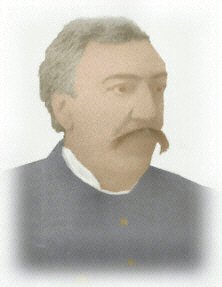
BIOGRAPHY OF THOMAS JEFFERSON LAFLESH
(Wisconsin Civil War Leader - Black River Lumberman
- Pioneer)
Captain Thomas Jefferson LaFlesh 1836 - 1905

Thomas Jefferson LaFlesh, Sr.
Courtesy
of Revival Arts![]()
Thomas Jefferson LaFlesh was born June 3, 1836, in
Leamington, Ontario, Canada, of French and Canadian parentage. His
parents were Pierre LaFleiche and Elizabeth nee Elliot. It is
believed that Tom LaFlesh's first stay in Clark County, WI,
occurred in about 1850, when as a teenager he assisted Amos Elliott
with logging interests north of Neillsville. What Tom saw in the
towering white pines along the banks of the Black River as a young
man left a lasting impression on him, one that made him want to
return and share in the beauty of the land and wealth of the timber
as well.
The Civil War took
Tom away for a time. In December of 1861, in La Crosse County,
Company B of the 2nd Wisconsin Cavalry was created. The unit was
mustered into service at Camp Washburn, near Milwaukee, Wisconsin,
on February 6, 1862, with a roster of 100 members. Thomas J.
LaFlesh was named at the onset of the unit as Second Lieutenant. On
March 24th the Company, with the Regiment, left Wisconsin and had
four years of active participation in the war. The 2nd Cavalry had
took part in the battle at Vicksburg, Miss, among others. When Tom
LaFlesh was mustered out in November of 1865, he had worked his way
up to Captain of Company B. The "1918 History of Clark County" book
tells of Captain Thomas LaFlesh, along with other veteran officers,
leading the Civil War Reunion parade on their steeds in the city of
Neillsville, Wisconsin. These reunions became popular for the
different regiments in the state and were held annually in the fall
for many years after the war's end. LaFlesh participated and was an
organizer and speaker at several of these reunions. In 1871 he
obtained permission for "Old Abe", the war eagle, to attend the
Neillsville Soldier's Reunion.
During LaFlesh's war service, he took time out to marry Elizabeth
Summerside, daughter of George and Mary Summerside, on August 27,
1863 at Black Earth, Wisconsin. The first land entry for Tom
purchasing acreage in Sherwood Township, Clark County, Wisconsin
was in 1869. At that time he is believed to have moved from
Necedah, Wisconsin, with his wife and two small children, Mary and
William, to the Sherwood area. Here his logging operations began
with the assistance of General Cadwallader Washburn (lumberman,
huge landowner, Wisconsin Congressman from 1869-1871, and governor
of Wisconsin from 1872-1874). At it's peak the Washburn land
holdings covered some 15 to 20 thousand acres of valuable
timberland located by Captain LaFlesh in central Wisconsin, along
with land in other areas. Washburn organized Company B of the
2nd Wisconsin Cavalry at the onset of the Civil War and apparently
took a liking to LaFlesh.
During the 1870's and 1880's LaFlesh was extensively engaged in the
logging business and kept his associations with C. C. Washburn. By
a special act of the state legislature, Tom was authorized to
construct and maintain dams on the East Fork of the Black River in
Clark, Jackson, and Wood Counties beginning June 1, 1880, for a
period of ten years. Among these was the logging dam in Section 14
of Sherwood Township. In 1883, he was in charge of building a dam
three miles north of Scranton (just east of City Point) on the East
Fork of the Black River. In January of 1884, he was in charge of
five logging camps on the East Fork and foresaw the best winters
logging ever, expecting to put in 15,000,000 feet of logs.
In 1889, Thomas LaFlesh left central Wisconsin and moved to
California with his family. Here he pursued mining and road
engineering. He died later in Portland, Oregon.
In 1905, at a reunion held for survivors of the Wisconsin Second
Cavalry in LaCrosse, a letter was read to the attendants from Capt.
LaFlesh. He was unable to attend from California because of his
declining health. Here is an excerpt from this letter in Tom's own
words. "I hope you may reap a rich harvest of enjoyment at this
meeting. I had hoped to be with you at this time, but my health
would not permit; though I still hope to meet many of you at some
future reunion. As I sit in my cabin door on the lonely Sierras,
looking to the west, the sun is slowly dipping behind the hills on
its way to the broad Pacific. To the east its rays still brighten
the high and hoary peaks; then the brightness vanishes from them,
too, and soon all will be folded in the robes of silent night. Thus
it is my comrades, with the grand old army. Morning and noontide
have passed; our star is also dipping behind the western hills as
our eventide draws on; its lingering rays still rest upon a few of
our hoary heads; they, too, will soon vanish and all will be dark
in the silence of the grave, leaving only the records of our words
and works for future generations."
Biography
Courtesy of Kay Scholtz
|
© Every submission is protected by the Digital Millennium Copyright Act of 1998.
Show your appreciation of this freely provided information by not copying it to any other site without our permission.
Become a Clark County History Buff
|
|
A site created and
maintained by the Clark County History Buffs
Webmasters: Leon Konieczny, Tanya Paschke, Janet & Stan Schwarze, James W. Sternitzky,
|